
Fiber-reinforced polymer reinforcement for concrete members
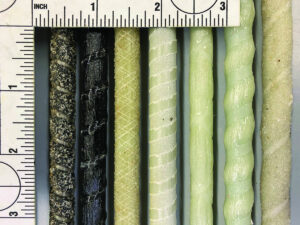
![]() Fiber-reinforced polymer (FRP) offers new capabilities for structural and nonstructural applications in building construction. FRP bars and, more recently, meshes (Figures 1 and 2) for use as concrete reinforcement have gained popularity by offering some distinct advantages such as resistance to corrosion, high stiffness-to-weight ratio, and relatively lower labor and handling costs. FRP bars have been successfully used as structural reinforcement in concrete members in building and bridge projects (for example, slabs and beams) for the past three decades. Figure 3 shows progress on the construction of a residential home in Great Harbour, Berry Island, Bahamas, where glass fiber-reinforced polymer (GFRP) reinforcement was used for all structural concrete elements, including the masonry walls. Figure 4 shows the use of GFRP straight and bent bars for the construction of the bent caps in a bridge replacement project at the 23rd Avenue over Ibis Waterway, Broward County, Fla.
Fiber-reinforced polymer (FRP) offers new capabilities for structural and nonstructural applications in building construction. FRP bars and, more recently, meshes (Figures 1 and 2) for use as concrete reinforcement have gained popularity by offering some distinct advantages such as resistance to corrosion, high stiffness-to-weight ratio, and relatively lower labor and handling costs. FRP bars have been successfully used as structural reinforcement in concrete members in building and bridge projects (for example, slabs and beams) for the past three decades. Figure 3 shows progress on the construction of a residential home in Great Harbour, Berry Island, Bahamas, where glass fiber-reinforced polymer (GFRP) reinforcement was used for all structural concrete elements, including the masonry walls. Figure 4 shows the use of GFRP straight and bent bars for the construction of the bent caps in a bridge replacement project at the 23rd Avenue over Ibis Waterway, Broward County, Fla.
Recently, there has also been interest in using FRP bars and meshes as secondary reinforcement for concrete members such as plain concrete footings, slabs-on-ground, and plain concrete walls in lieu of conventional temperature and shrinkage steel reinforcement. The use of basalt fiber-reinforced polymer (BFRP) mesh as secondary reinforcement is shown in Figure 5. BFRP mesh was used for this project at Florida Keys Marathon International Airport in Marathon, Fla. The mesh comprised 3.6 mm (0.14 in.) diameter wire fabricated in a 100 x 100 mm (4 x 4 in.) orthogonal grid. The floor slab constructed on an existing concrete slab (with cracks and gaps) is used for light aircraft hangar. The slab thickness varies from 100 to 150 mm (4 to 6 in.).
The evaluation of FRP bars and meshes used as primary or secondary concrete reinforcement in compliance with the legally adopted building codes in the United States is the topic of this article.
Building codes in the United States
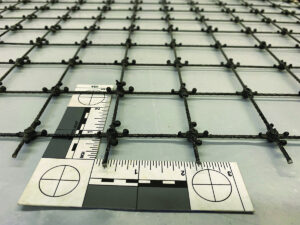
nonstructural polymer connector.
In the United States, where the power to regulate construction is vested in local authorities, a system of model building codes is used. The International Building Code (IBC) and the International Residential Code (IRC) are the two model codes that have been developed to establish the minimum requirements to safeguard public health and safety. In general, the IBC and IRC address structural strength, means of egress, sanitation, adequate lighting and ventilation, accessibility, energy conservation, and life safety regarding new and existing buildings, facilities, and systems. Currently, the IBC has been adopted throughout the entire country, as well as the U.S. territories, while the IRC has also been adopted by most of the states.
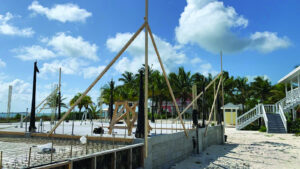
concrete columns and masonry walls included FRP reinforcement.
Engineers and architects are usually guided by national and local building codes that are based on the model codes. These model codes become especially important when compliance with the legally adopted building code is mandated by a jurisdiction having the authority to approve construction projects. Compliance can be readily achieved when a design incorporates materials or assemblies covered in the IBC or IRC. However, when a design incorporates materials or assemblies that are not specifically covered in the IBC and IRC, building code compliance may need to be demonstrated. Section 104.11 of the IBC provisions[1] allows an alternative material, design, or method of construction to be approved, where the building official finds that the proposed design is satisfactory and complies with the intent of the provisions of this code, provided the material and method under evaluation is, for the purpose intended, at least the equivalent of that prescribed in quality, strength, effectiveness, fire resistance, durability, and safety. Subsection 104.11.1 of the IBC, which refers to research reports, allows such reports to be issued by approved sources where necessary to assist in the approval of materials or assemblies not specifically covered.
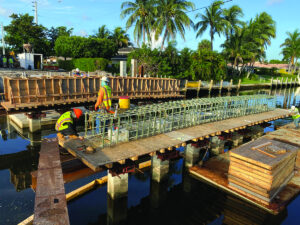
were reinforced with FRP reinforcing bars supplied in both straight
and pre-bent forms.
The more permanent option would be to revise the IBC and IRC to allow alternative materials or assemblies, such as FRP bars and mashes to be used as structural and secondary reinforcement; however, such revisions must go through the lengthy, public comment and approval process of the International Code Council. To this end, ACI Committee 440, Fiber-Reinforced Polymer Reinforcement, has commenced the development of a mandatory language design code governing the use of FRP reinforcement. This code will be dependent on the ACI 318 Code[2] and designed to be readily adopted by reference into the model and local building codes.
Creating a code compliance in accordance with Section 104.11 of the IBC is the preferred method. This is typically accomplished through product testing in accordance with an acceptance criteria (AC), which defines product sampling, testing, and quality requirements to be fulfilled to obtain code compliance verification. The results of these requirements are summarized in a research report made available to code officials, as set forth in Section 104.11.1 of the IBC. The research reports are typically issued by certification bodies that are accredited as complying with ISO/IEC 17065.[3] All testing must be conducted by a laboratory that complies with ISO/IEC 17025.[4] The certification body (evaluation agency) requires accreditation by a recognized accreditation body, which directly verifies the competence of a laboratory by visiting the facility and observing its personnel during testing. The accreditation body must also determine whether the laboratory has a robust quality system to assure the accuracy of reported results and have the means to investigate and make corrections when reports are questioned.
To date, the IBC and IRC do not include provisions for use of FRP bars and meshes as replacement of steel reinforcement. Chapter 19 of the IBC refers to ACI 318 for the design of reinforced concrete buildings; similarly, ACI 318 also does not address the use of FRP bars and meshes as a replacement for steel reinforcement. Therefore, AC for use of FRP as reinforcement of concrete, AC454[5] and AC521[6], have been developed by ICC Evaluation Service (ICC-ES) under Section 104.11 of the IBC and Section R104.11 of the IRC.[7]
Acceptance criteria for building code compliance
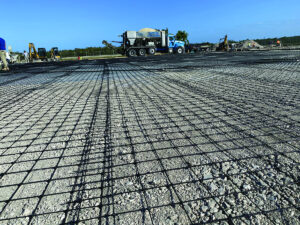
The development of an AC usually starts with an application from an interested party who oversees the invention or production of an alternative construction product, system, or technology. After a review of the IBC and IRC to confirm that the proposed alternative is not within the provisions of the IBC or IRC, an AC is drafted with the help of producers, academics, and other interested parties. The draft AC is then shared with the public, through an open, online web posting, to solicit comments. Public comments are collected, a response letter by the proponents of the proposed criteria is prepared and shared publicly, and further revisions are implemented if necessary. As a final step, open public hearings are held, with selected independent code officials acting as an evaluation committee that listens to the concerns of the public and the responses of the AC proponents and poses their own questions and comments. The evaluation committee then votes on the proposed AC. A simple majority is required for an AC to be accepted and issued. Because the use of FRP bars and meshes as primary or secondary reinforcement is not within the current code provisions, AC454 and AC521 have been developed under Section 104.11 of the IBC and Section R104.11 of the IRC, with final approval dates of October 2020 and December 2020, respectively.
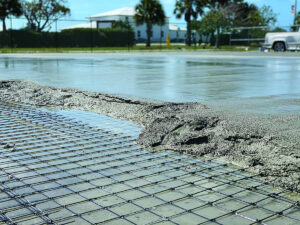
AC454 applies to GFRP or BFRP bars, in cut lengths, bent shapes, and continuous closed stirrups and ties (hoops), that are used to reinforce concrete structural members. The AC requires evaluation of physical and mechanical properties, performance under accelerated environmental exposures, performance under exposure to fire conditions, and structural design procedures. AC454 is applicable to FRP bars that are solid and have circular or noncircular cross-sections, or hollow and have circular cross-sections. Bars meeting AC454 are used as reinforcement in structural concrete members such as columns, beams, walls, shallow foundations, and one-way or two-way slabs, and as shear reinforcement for flexural members. Under AC454, FRP bars are limited to structures constructed in Seismic Design Category A or B using normal-weight concrete. AC454 references include ASTM D7957/D7957M-17[8] for most of the required testing and ACI 440.1R-15[9] for design provisions. However, AC454 also describes full-scale structural tests for members reinforced with noncircular solid FRP bars or circular hollow FRP bars.
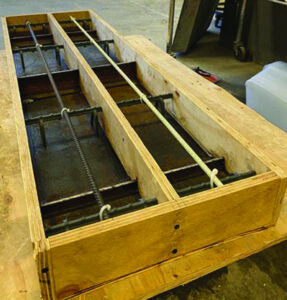
AC521 applies to glass or basalt FRP bars in cut lengths or meshes produced with solid wires with continuous, uninterrupted circular cross-sections. Items evaluated under AC521 include physical and mechanical properties. FRP bars and meshes evaluated under the AC521 are used as alternatives to the shrinkage and temperature reinforcement specified in Section 24.4 of ACI 318-19 for plain concrete footings and for plain concrete slabs-on-ground (as defined by ACI 360R-10[10]). However, this AC does not eliminate the requirement for joints specified in Section 14.3.4 of ACI 318-19 (and thus the IBC and IRC). FRP bars and meshes under this AC are also used as an alternative to horizontal temperature and shrinkage reinforcement in structural plain concrete walls covered in IBC Section 1906, IRC Sections R404.1.3 and R608.1, and ACI 332-14, Sections 8.2.1 and 8.2.7,[11] excluding walls where vertical reinforcement is required. AC521 also provides provisions for shrinkage cracking testing (Figure 7). The purpose of the shrinkage cracking test is to demonstrate equivalency between a given FRP bar or mesh configuration (that is, FRP cross-section size and spacing) and a selected steel reinforcement configuration, in terms of control of shrinkage cracking performance. The intent is to allow the contractor to obtain the building official’s approval for the use of an FRP solution as an alternative to a steel solution, without the need for additional testing or engineering calculations.
Besides testing in accordance with the requirements of acceptance criteria, an equally important aspect of product evaluation is the requirement for documentation of quality control measures during the manufacture of the materials. The measures are intended to verify that the produced materials will match the performance as previously demonstrated by testing. As a means of verification, the quality system needs to be inspected by an accredited inspection agency. The inspection agency must be independent and conform to requirements stipulated in ISO/IEC 17020,[12] as determined by a recognized accreditation body. The evaluation agency is charged with requiring that the inspection agency inspect each manufacturing location regularly, and not less than once per year, to provide assurance that the FRP materials are produced and conform to critical performance and measurements set forth in quality documentation.
Summary
ACI Committee 440 is progressing with the development of an ACI 318-dependent, mandatory language design code governing the use of FRP reinforcement. The committee expects the document to be completed by 2022. Once this code is published by ACI, it will be submitted for public review through the International Code Council process so it can be adopted into the IBC and IRC for concrete building construction.
The IBC and IRC are the predominant building and residential codes in the United States. To construct buildings using alternative materials that are not covered by the codes, two options exist:
- The building code must incorporate the new technology through the public hearing process of the International Code Council, or
- Building code compliance is shown, based on Section 104.11 of the IBC or Section R104.11 of the IRC.
The first case may be accomplished once ACI Committee 440 has successfully developed a design code. The second case requires that the proponent of the alternative materials demonstrates building code compliance via AC454 or AC521, where AC454 applies to structural reinforcement applications and AC521 applies to shrinkage and temperature reinforcement applications.
References
- “2021 International Building Code (IBC),” International Code Council, Country Club Hills, IL, 2021, 833 pp.
- ACI Committee 318, “Building Code Requirements for Structural Concrete (ACI 318-19) and Commentary (ACI 318R-19),” American Concrete Institute, Farmington Hills, MI, 2019, 623 pp.
- ISO/IEC 17065:2012, “Conformity Assessment – Requirements for Bodies Certifying Products, Processes and Services,” International Organization for Standardization, Geneva, Switzerland, 2012, 27 pp.
- ISO/IEC 17025:2017, “General Requirements for the Competence of Testing and Calibration Laboratories,” International Organization for Standardization, Geneva, Switzerland, 2017, 30 pp.
- AC454, “Acceptance Criteria for Fiber-Reinforced Polymer (FRP) Bars for Internal Reinforcement of Concrete Members,” ICC Evaluation Services, Inc., Country Club Hills, IL, 2020, 20 pp.
- AC521, “Acceptance Criteria for Fiber-Reinforced Polymer (FRP) Bars and Meshes for Internal Reinforcement of Non-Structural Concrete Members,” ICC Evaluation Services, Inc., first edition, Country Club Hills, IL, 2020, 8 pp.
- “2021 International Residential Code (IRC),” International Code Council, Country Club Hills, IL, 2021.
- ASTM D7957/D7957M-17, “Standard Specification for Solid Round Glass Fiber Reinforced Polymer Bars for Concrete Reinforcement,” ASTM International, West Conshohocken, PA, 2017, 5 pp.
- ACI Committee 440, “Guide for the Design and Construction of Structural Concrete with Fiber-Reinforced Polymer Bars (ACI 440.1R-15),” American Concrete Institute, Farmington Hills, MI, 2015, 88 pp.
- ACI Committee 360, “Guide to Design of Slabs-on-Ground (ACI 360R-10),” American Concrete Institute, Farmington Hills, MI, 2010, 72 pp.
- ACI Committee 332, “Residential Code Requirements for Structural Concrete (ACI 332-14) and Commentary,” American Concrete Institute, Farmington Hills, MI, 2014, 56 pp.
- ISO/IEC 17020:2012, “Conformity Assessment – Requirements for the Operation of Various Types of Bodies Performing Inspection,” International Organization for Standardization, Geneva, Switzerland, 2012, 18 pp.
This article originally appeared in the February 2021 issue of Concrete International and is reprinted with permission.










